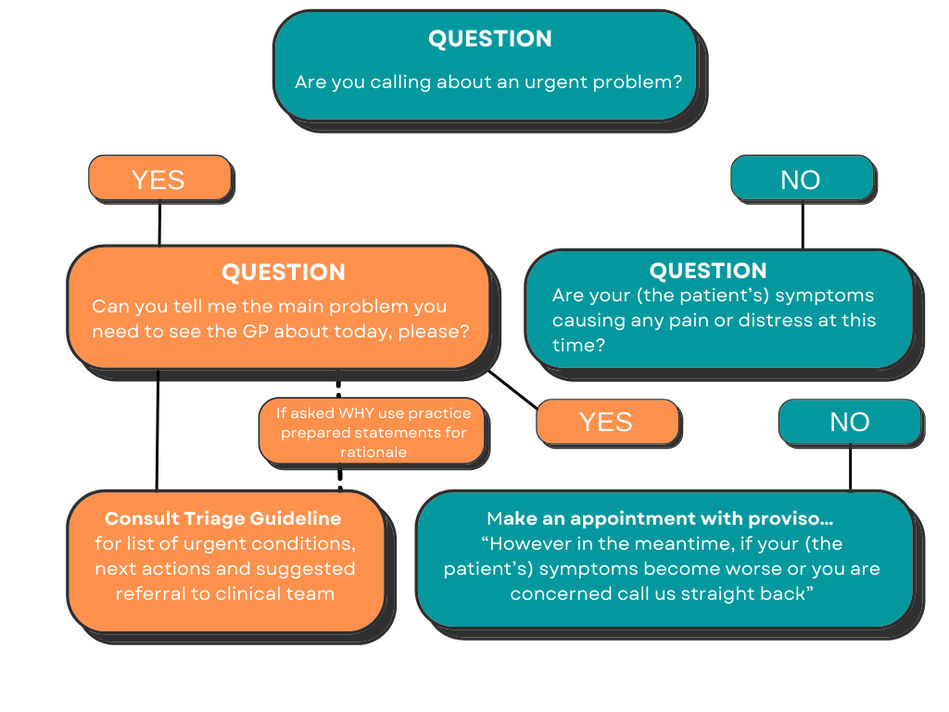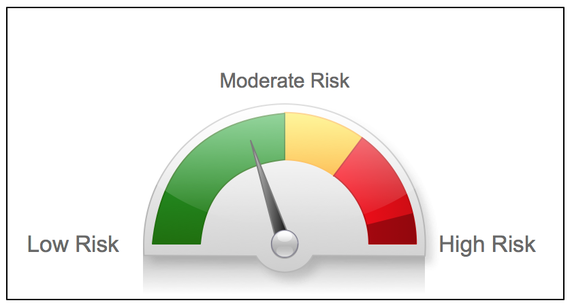triage flowchart
front desk
Patient seeking same-day "urgent" appointment by telephone or as a walk-in
If the patient or caller is reluctant to answer this question,
click on the box below for some rationales to use.
click on the box below for some rationales to use.
Select the category of the main problem the patient has. (SEE LIST AT THE BOTTOM OF THIS PAGE FOR GUIDANCE)
Alternatively you can go to our Key Word Search to provide a quick guide for action
ASK YOURSELF
IS THE CONDITION A LIFE OR LIMB THREATENING EMERGENCY?
There are some conditions that will always require emergency Ambulance assistance - Advice caller to Dial OOO
If the patient refuses or you are uncertain , refer call to nurse or GP immediately
ASK YOURSELF
IS THE CONDITION A LIFE OR LIMB THREATENING EMERGENCY?
There are some conditions that will always require emergency Ambulance assistance - Advice caller to Dial OOO
If the patient refuses or you are uncertain , refer call to nurse or GP immediately
Now go to our Triage Chart
to select the main problem and determine appropriate actions and referral
to select the main problem and determine appropriate actions and referral
AMBULANCE OOO
- Respiratory and/or Cardiac Arrest
- Chest pain or chest tightness (Chest pain lasting longer than 20 minutes or that is associated with sweating, shortness of breath or radiation to another part of the body is to be considered a ‘heart attack’ until proven otherwise, regardless of the age of the patient).
- Severe heart palpitations
- Sudden onset of weakness, numbness or paralysis of the face, arm or leg
- Severe breathing difficulties - can only speak in short sentences
- Unconsciousness
- Uncontrollable bleeding
- Vomiting blood
- Sudden collapse or unexplained fall
- Unexplained fitting in adults
- Assault including a stabbing or shooting or an assault using another weapon
- Injuries caused by a motor vehicle accident >60km/h or pedestrian/cyclist >30km/h
- Fall from greater than the patient's own height
- Suspected spinal injury
- Severe burns, particularly in young children (greater than the victims hand or if deeper than the top layer of skin in any person)
- Infant/ toddler that is fitting
- Severe pain for any reason
- Any overdose, poisoning or attempted suicide
- A bite or sting from any large spider, snake or suspected venomous creature
- A suspected severe allergic reaction/ anaphylaxis
- Seizure without a previous diagnosis of epilepsy
- Seizures that are frequent and/or repeating in an epileptic patient
- Fainting
EMERGENCY DEPARTMENT
Some of these conditions may require Ambulance treatment and transport to an Emergency Department
Some of these conditions may require Ambulance treatment and transport to an Emergency Department
- Broken bones or dislocated joints - deformed or not in normal alignment
- Deep cuts that require sutures – especially on the face
- Head injuries - where there has been a loss of consciousness or persistent dizziness and/or vomiting
- Embedded object in the eye
- Severe flu-like symptoms or coughing up blood
- Sudden change in mental state or difficulty speaking
- Sudden changes in vision
- Persistent high fever despite medication
- Young children who have stopped drinking or passing urine
- Any sudden, severe pain, especially in the abdomen or the back
- Anything impaled in any part of the body
- Burns especially to face or genitals
- Unusual headaches or migraines for the patient
- Cuts with exposed tissue or where the feeling or temperature of the part is not normal
- Inability to urinate
- Pain in pregnancy
- Pregnancy - reduced movement
- Pregnancy - ruptured membranes
- Severe testicular pain
GENERAL PRACTICE or AH SERVICE
DISCUSS WITH GP OR NURSE NOW
- Bites and Stings - if there difficulty breathing or the bite is from a any large black spider or any snake or known venomous creature, the patient should be directed to Ambulance OOO
- Abdominal Pain - if the abdominal pain is so severe that it changes the patient's posture i.e. they must walk bent over or lie with their knees drawn to their chest; this is highly suggestive of referral directly to an Emergency Department.
- Lacerations - if the bleeding cannot be controlled or is from any body orifice or is longer than 20mm or if there is white or yellow substances visible in the wound; this is highly suggestive of referral directly to an Emergency Department.
- Convulsions/Fitting (not current)
- Limb Injury - if the limb is deformed or not in normal alignment or is pale compared to the other limb or there is a loss of function or feeling in the limb or the patient cannot bear weight/walk; this is highly suggestive of referral directly to an Emergency Department.
- Limb Pain (without injury)
- Eye or vision problems - any obvious injury to the eye or an embedded object or sudden loss of sight or the quality of sight; this is highly suggestive of referral directly to an Emergency Department.
- Suspected Meningitis - concern by parent or carer
- Mental Health Problems or Extreme Anxiety - including suicide ideation
- Severe pain (from any cause not mentioned in Ambulance or ED lists)
- Burns/Scalds - if any part of the burn is black or charred or the burnt area is bigger than the patients hand; this is highly suggestive of referral directly to an Emergency Department.
- Death of a patient
- Urgent Pathology Result
- Fevers (hot to touch) in infants especially a newborn to 3 months
- Vaginal bleeding in pregnancy
- Persistent vomiting
- Adverse reaction to medication
- Parent/carer concern
DISCUSS WITH GP OR NURSE WITHIN 30 MINUTES
- Swollen Limb
- Under-dose (Including missed dose)
- Prescription has run out - refer to GP or nurse to determine urgency and solution
COME TO THE PRACTICE NOW TO BE ASSESSED BY NURSE OR GP
- Sudden Rash - without other symptoms
- Unwell Child (<3yo) or Elderly Patient (>65yo) - with persistent symptoms (>48hrs) such as fever, vomiting, diarrhoea, cough)
- Adult Vomiting and/or Diarrhoea for > 72 hrs
MAKE AN APPOINTMENT TODAY OR WITHIN 6 HOURS (IF UNABLE TO MEET TIME FRAME DISCUSS WITH NURSE OR GP)
- Back Pain - associated with an accident (e.g. fall, MVA, lifting) provided the patient has no loss of feeling or function in a limb and no loss of bladder or bowel control.
- Eye Problems
- Ear Pain - despite pain relief >48 hrs
- Fever in Adults - who are otherwise well
- Flu-like symptoms - with current symptoms of risk
- Post-operative Problems - if there is active bleeding DISCUSS WITH GP OR NURSE NOW
- Urinary Problems - but able to urinate
- Wound Infection
- Sickness Certificate
- Worker's Compensation (injury first report)
- Patient has no other opportunity to see GP
- Patient has a deadline for travel or specialist appointment needing referral
The above list has been formulated to assist practice staff in establishing the broad risk patients based on their chief complaint and/or situation. It is not designed to be diagnostic but to assist practice staff in the timely referral to practice clinical staff and other places of care for emergency matters. This system is based on a variety of clinical guidelines and evidence from general practice feedback. The authors have prepared this resource for practices based on the information available at the time. As the authors cannot control how the resource is used in practices, they accept no liability for using or not using this information.
Copyright - Medics for Life 2016





